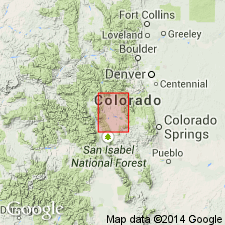
- Usage in publication:
-
- Balfour formation
- Modifications:
-
- Principal reference
- Dominant lithology:
-
- Ash
- Tuff
- Trachyte
- Conglomerate
- AAPG geologic province:
-
- South Park basin
Summary:
Pg. 34 (table 7), 61-63, pl. 1. Balfour formation. Sequence of stream-channel, flood-plain, alluvial-fan, deltaic, and true lake sediments. Thickness 0 to 200 feet. Relation to Denver formation nowhere exposed; may prove to be merely topmost part of the Denver. [Age is early Oligocene.]
[Type area:] best exposed north of Balfour in T. 13 S., R. 75 W. Scattered outcrops occur within area extending from R. 74 to R. 76 W., and from T. 14 to T. 12 S., Park Co., central CO.
Source: US geologic names lexicon (USGS Bull. 1200, p. 205).

- Usage in publication:
-
- Balfour Formation†
- Modifications:
-
- Abandoned
Summary:
Is equivalent in lithology, origin, and age to the Antero Formation (adopted). Name Balfour abandoned as an Oligocene unit in the South Park basin.
Source: GNU records (USGS DDS-6; Denver GNULEX).
For more information, please contact Nancy Stamm, Geologic Names Committee Secretary.
Asterisk (*) indicates published by U.S. Geological Survey authors.
"No current usage" (†) implies that a name has been abandoned or has fallen into disuse. Former usage and, if known, replacement name given in parentheses ( ).
Slash (/) indicates name conflicts with nomenclatural guidelines (CSN, 1933; ACSN, 1961, 1970; NACSN, 1983, 2005, 2021). May be explained within brackets ([ ]).

